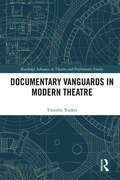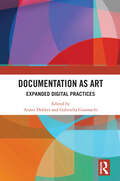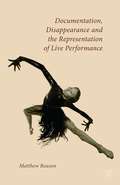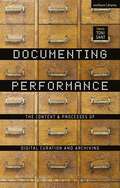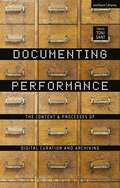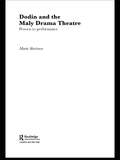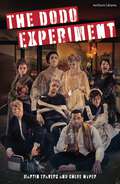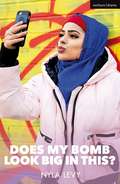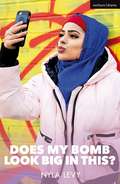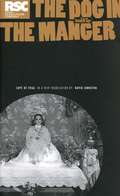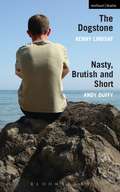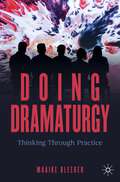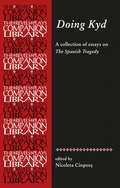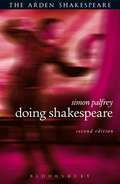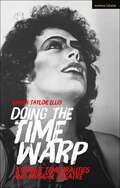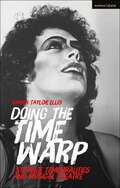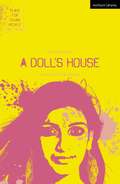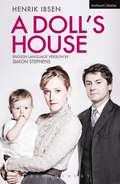- Table View
- List View
Documentary Vanguards in Modern Theatre (Routledge Advances in Theatre & Performance Studies)
by Timothy YoukerPractitioners and critics alike often attribute great authenticity to documentary theatre, casting it as a salutary alternative not only to corporate news outlets and official histories but also to the supposed "self-indulgence" and "elitism" of avant-garde theatre. Documentary Vanguards in Modern Theatre, by contrast, argues for treating documentarians as vanguardists who (for good or ill) push, remap, or transgress the margins of historical and political visibility, often taking issue with professional discourses that claim a monopoly on authoritative representations of the real. This is the first book to situate documentary theatre’s development within the larger story of theatrical experimentalism, collage art, collective ritual, and other avant-garde dramaturgical and performance practices of the late 19th and 20th Centuries.
Documentary Vanguards in Modern Theatre (Routledge Advances in Theatre & Performance Studies)
by Timothy YoukerPractitioners and critics alike often attribute great authenticity to documentary theatre, casting it as a salutary alternative not only to corporate news outlets and official histories but also to the supposed "self-indulgence" and "elitism" of avant-garde theatre. Documentary Vanguards in Modern Theatre, by contrast, argues for treating documentarians as vanguardists who (for good or ill) push, remap, or transgress the margins of historical and political visibility, often taking issue with professional discourses that claim a monopoly on authoritative representations of the real. This is the first book to situate documentary theatre’s development within the larger story of theatrical experimentalism, collage art, collective ritual, and other avant-garde dramaturgical and performance practices of the late 19th and 20th Centuries.
Documentation as Art: Expanded Digital Practices
by Annet Dekker Gabriella GiannachiDocumentation as Art presents documentation as an expanded practice that is radically changing the ways in which to look at, participate in, and generate art. Bringing together expertise from different disciplines, the book provides an in-depth investigation of the development of documentation as a set of production, circulation, and preservation strategies. Illustrating how these are often led by artists, audiences, and museums, the contributions offer new insights into digital art and its history, curation, and preservation, through documentation. Considering documentation as the main method of preserving these art forms, the book analyses how it can address the inherent challenges of capturing live events, visitor experiences, and evolving artworks. Showing how documentation itself can become (part of) an original artwork, the book discusses ways in which these expanded practices can impact the value and experience of the documented event or artwork, giving consideration to how this might affect the traditional authority of the museum as creator of documentation used for future reference, historical relevance, or cultural memory. Documentation as Art demonstrates how the curation and preservation of documentation and the introduction of audience-generated documentation are radically changing exhibition and visiting practices in which documentation is becoming a significant and emergent cultural form in its own right. The book will appeal to researchers and students engaged in the study of museums and curation, art and art history, performance, new media and digital art, library and information science, and conservation.
Documentation as Art: Expanded Digital Practices
by Annet Dekker Gabriella GiannachiDocumentation as Art presents documentation as an expanded practice that is radically changing the ways in which to look at, participate in, and generate art. Bringing together expertise from different disciplines, the book provides an in-depth investigation of the development of documentation as a set of production, circulation, and preservation strategies. Illustrating how these are often led by artists, audiences, and museums, the contributions offer new insights into digital art and its history, curation, and preservation, through documentation. Considering documentation as the main method of preserving these art forms, the book analyses how it can address the inherent challenges of capturing live events, visitor experiences, and evolving artworks. Showing how documentation itself can become (part of) an original artwork, the book discusses ways in which these expanded practices can impact the value and experience of the documented event or artwork, giving consideration to how this might affect the traditional authority of the museum as creator of documentation used for future reference, historical relevance, or cultural memory. Documentation as Art demonstrates how the curation and preservation of documentation and the introduction of audience-generated documentation are radically changing exhibition and visiting practices in which documentation is becoming a significant and emergent cultural form in its own right. The book will appeal to researchers and students engaged in the study of museums and curation, art and art history, performance, new media and digital art, library and information science, and conservation.
Documentation, Disappearance and the Representation of Live Performance
by M. ReasonThe documentation of practice is one of the principle concerns of performance studies. Focusing on contemporary performance practice and with emphasis on the transformative impact of video, photography and writing, this book explores the ideological, practical, and representational implications of knowing performance through its documentations.
Documenting Performance: The Context and Processes of Digital Curation and Archiving
by Toni SantPerformance in the digital age has undergone a radical shift in which a once ephemeral art form can now be relived, replayed and repeated. Until now, much scholarship has been devoted to the nature of live performance in the digital age; Documenting Performance is the first book to provide a collection of key writings about the process of documenting performance, focused not on questions of liveness or the artistic qualities of documents, but rather on the professional approaches to recovering, preserving and disseminating knowledge of live performance.Through its four-part structure, the volume introduces readers to important writings by international practitioners and scholars on:* the contemporary context for documenting performance* processes of documenting performance* documenting bodies in motion* documenting to createIn each, chapters examine the ways performance is documented and the issues arising out of the process of documenting performance. While theorists have argued that performance becomes something else whenever it is documented, the writings reveal how the documents themselves cannot be regarded simply as incomplete remains from live events. The methods for preserving and managing them over time, ensuring easy access of such materials in systematic archives and collections, requires professional attention in its own right. Through the process of documenting performance, artists acquire a different perspective on their own work, audiences can recall specific images and sounds for works they have witnessed in person, and others who did not see the original work can trace the memories of particular events, or use them to gain an understanding of something that would otherwise remain unknown to them and their peers.
Documenting Performance: The Context and Processes of Digital Curation and Archiving
by Toni SantPerformance in the digital age has undergone a radical shift in which a once ephemeral art form can now be relived, replayed and repeated. Until now, much scholarship has been devoted to the nature of live performance in the digital age; Documenting Performance is the first book to provide a collection of key writings about the process of documenting performance, focused not on questions of liveness or the artistic qualities of documents, but rather on the professional approaches to recovering, preserving and disseminating knowledge of live performance.Through its four-part structure, the volume introduces readers to important writings by international practitioners and scholars on:* the contemporary context for documenting performance* processes of documenting performance* documenting bodies in motion* documenting to createIn each, chapters examine the ways performance is documented and the issues arising out of the process of documenting performance. While theorists have argued that performance becomes something else whenever it is documented, the writings reveal how the documents themselves cannot be regarded simply as incomplete remains from live events. The methods for preserving and managing them over time, ensuring easy access of such materials in systematic archives and collections, requires professional attention in its own right. Through the process of documenting performance, artists acquire a different perspective on their own work, audiences can recall specific images and sounds for works they have witnessed in person, and others who did not see the original work can trace the memories of particular events, or use them to gain an understanding of something that would otherwise remain unknown to them and their peers.
Dodin and the Maly Drama Theatre: Process to Performance
by Maria ShevstovaIncluding a foreword by Simon Callow, a dedicated admirer of the Maly, Dodin and the Maly Drama Theatre provides both a valuable methodological model for actor training and a unique insight into the journeys taken from studio to stage. This is the first ever full-length study of internationally-acclaimed theatre company, the Maly Drama Theatre of St. Petersburg, and its director, Lev Dodin.Maria Shevtsova provides an illuminating insight into Dodin's directorial processes and the company's actor 4raining, devising and rehearsal methods, which she interweaves with detailed analysis of the Maly's main productions. Dodin and the Maly Drama Theatre: Process to Performance demonstrates how the impact of Dodin's work extends far beyond that of his native Russia, and gives the reader unparalleled access to the company's practice.
Dodin and the Maly Drama Theatre: Process to Performance
by Maria ShevstovaIncluding a foreword by Simon Callow, a dedicated admirer of the Maly, Dodin and the Maly Drama Theatre provides both a valuable methodological model for actor training and a unique insight into the journeys taken from studio to stage. This is the first ever full-length study of internationally-acclaimed theatre company, the Maly Drama Theatre of St. Petersburg, and its director, Lev Dodin.Maria Shevtsova provides an illuminating insight into Dodin's directorial processes and the company's actor 4raining, devising and rehearsal methods, which she interweaves with detailed analysis of the Maly's main productions. Dodin and the Maly Drama Theatre: Process to Performance demonstrates how the impact of Dodin's work extends far beyond that of his native Russia, and gives the reader unparalleled access to the company's practice.
The Dodo Experiment (Modern Plays)
by Martin Travers Chloe WyperWhat money?! This ends when you end. This experiment is about the survival of the fittest. Nothing more – nothing less.Imprisoned in an abandoned warehouse, a desperate group of failing actors are trapped in a dark experiment. After months of endlessly rehearsing George Bernard Shaw's Pygmalion with no director to guide them, some of the ensemble have disappeared leaving the others paranoid and subservient. Sleep-deprived and half-starved, their fragile social bonds shatter and implode as a stranger breaks in and incites them to rebel. This new dystopian thriller about a group of aspiring actors trapped in a dark social experiment is a collaboration from writers Martin Travers and Chloe Wyper. This edition was published to coincide with the run presented by the Citizens Theatre's WAC Ensemble in April 2022.
The Dodo Experiment (Modern Plays)
by Martin Travers Chloe WyperWhat money?! This ends when you end. This experiment is about the survival of the fittest. Nothing more – nothing less.Imprisoned in an abandoned warehouse, a desperate group of failing actors are trapped in a dark experiment. After months of endlessly rehearsing George Bernard Shaw's Pygmalion with no director to guide them, some of the ensemble have disappeared leaving the others paranoid and subservient. Sleep-deprived and half-starved, their fragile social bonds shatter and implode as a stranger breaks in and incites them to rebel. This new dystopian thriller about a group of aspiring actors trapped in a dark social experiment is a collaboration from writers Martin Travers and Chloe Wyper. This edition was published to coincide with the run presented by the Citizens Theatre's WAC Ensemble in April 2022.
Does My Bomb Look Big in This? (Modern Plays)
by Nyla LevyYasmin Sheikh feels torn in the city she used to call home, but Aisha sees a different London to her best friend. When Yasmin suddenly disappears to Syria, Aisha embarks on a mission to uncover the truth and decide whether there is any hope in Yasmin's new-found world.First conceived in 2016 after being cast in roles as a 'jihadi bride' or 'terrorist girlfriend' and generally dissatisfied with the narrative being told, Nyla Levy ran research workshops with school children and interviewed muslim community leaders as well as terrorism defence solicitor Tasnime Akunjee. The result voices the complexities of the choices made by disaffected youth, their vulnerability, and how the decisions made can changes lives, communities and countries forever.With fierce wit and disarming honesty, Does My Bomb Look Big in This? cleverly unveils a human story behind the headlines and questions how close or far we are from multicultural harmony.
Does My Bomb Look Big in This? (Modern Plays)
by Nyla LevyYasmin Sheikh feels torn in the city she used to call home, but Aisha sees a different London to her best friend. When Yasmin suddenly disappears to Syria, Aisha embarks on a mission to uncover the truth and decide whether there is any hope in Yasmin's new-found world.First conceived in 2016 after being cast in roles as a 'jihadi bride' or 'terrorist girlfriend' and generally dissatisfied with the narrative being told, Nyla Levy ran research workshops with school children and interviewed muslim community leaders as well as terrorism defence solicitor Tasnime Akunjee. The result voices the complexities of the choices made by disaffected youth, their vulnerability, and how the decisions made can changes lives, communities and countries forever.With fierce wit and disarming honesty, Does My Bomb Look Big in This? cleverly unveils a human story behind the headlines and questions how close or far we are from multicultural harmony.
The Dog in The Manger (Oberon Modern Plays)
by David Johnston Lope de la VegaThe Spanish Golden Age celebrated one of the most dynamic, energetic and stylish periods of world drama which exploded onto the stages of Madrid at the turn of the seventeenth century. It was a decisive period in world drama, similar to the periods of great national drama which occurred in seventeenth century London and fifth century Athens. The Spanish Golden Age was big business - professional, commercial theatre with plays touring all over Spain and Europe Lope de Vega was one of the Spanish Golden Age's best known playwrights. In his classic The Dog in the Manger, Diana, Countess of Belfor, a beautiful and headstrong young woman, is beset by aristocratic suitors urging marriage but refuses them all. One-night she discovers her handsome young secretary seducing her favourite lady in waiting and is consumed with jealousy. A heartbreaking love triangle is forged and so begins a tale of forbidden love, envy and passion. The Dog in the Manger is a painful and hilarious comedy for anyone who has ever fallen in love with someone they shouldn't have'
'The Dogstone' and 'Nasty, Brutish and Short' (Modern Plays)
by Kenny Lindsay Andy DuffyPresented by the National Theatre of Scotland and the Traverse Theatre as a double-bill as part of their Debuts season, these two shorts plays take an unflinching look at the darker side of Scottish families. In Kenny Lindsay's The Dogstone, a father and son aren't seeing eye to eye in Oban. Teenager Lorn is trying to get his life started as his Dad is throwing his away with last night's empties. He's a 'heroic drinker' who loves to tell Lorn the local legends and stories of warriors, kings and the fabled Dogstone. Just how far can his fantasies take him? Andy Duffy's Nasty, Brutish and Short finds two brothers, Jim and Luke, holed up in a Glasgow flat. No job, no money and it looks like the only things on offer are all bad. As the options start to run out, Jim takes what isn't his and sets the two brothers on a collision course . . .
'The Dogstone' and 'Nasty, Brutish and Short' (Modern Plays)
by Kenny Lindsay Andy DuffyPresented by the National Theatre of Scotland and the Traverse Theatre as a double-bill as part of their Debuts season, these two shorts plays take an unflinching look at the darker side of Scottish families. In Kenny Lindsay's The Dogstone, a father and son aren't seeing eye to eye in Oban. Teenager Lorn is trying to get his life started as his Dad is throwing his away with last night's empties. He's a 'heroic drinker' who loves to tell Lorn the local legends and stories of warriors, kings and the fabled Dogstone. Just how far can his fantasies take him? Andy Duffy's Nasty, Brutish and Short finds two brothers, Jim and Luke, holed up in a Glasgow flat. No job, no money and it looks like the only things on offer are all bad. As the options start to run out, Jim takes what isn't his and sets the two brothers on a collision course . . .
Doing Dramaturgy: Thinking Through Practice (New Dramaturgies)
by Maaike BleekerThis book explores how doing dramaturgy is informed by today’s highly diverse field of theatre, dance and performance. It does so in dialogue with fourteen performances and their makers, tracing the thinking-through-practice that underlies these creations. The first part of the book looks at how dramaturgs participate in practices of thinking-making and introduces a dramaturgical mode of looking at performances and the processes in which they are created. The second part of the book discusses the performances and creative processes of Manuela Infante, Julian Hetzel, Ivo van Hove, Anouk van Dijk, Falk Richter, Milo Rau, Kris Verdonck, Death Centre, Hotel Modern, Jr.cE.sA.r , Emio Greco and Pieter C. Scholten, Dries Verhoeven, the LGB Society of Mind, Sanja Mitrović, and Amanda Piña. Showing how ways of making and ways of doing dramaturgy mutually inform each other, this book is an essential resource for students and others aspiring to develop their own dramaturgical practice.
Doing Kyd: Essays on The Spanish Tragedy
by Martin White Paul EdmondsonDoing Kyd reads Thomas Kyd’s The Spanish Tragedy, the box-office and print success of its time, as the play that established the revenge genre in England and served as a ‘pattern and precedent’ for the golden generation of early modern playwrights, from Marlowe and Shakespeare to Middleton, Webster and Ford. Interdisciplinary in approach and accessible in style, this collection is crucial in two respects: firstly, it has a wide spectrum, addressing readers with interests in the play from its early impact as the first sixteenth-century revenge tragedy, to its afterlife in print, on the stage, in screen adaptation and bibliographical studies. Secondly, the collection appears at a time when Kyd and his play are back in the spotlight, through renewed critical interest, several new stage productions between 2009 and 2013, and its firm presence in higher-education curriculum for English and drama.
Doing Shakespeare (Arden Shakespeare)
by Simon PalfreyA throroughly revised edition of the successful student text Doing Shakespeare, first published in 2005. The book's success lies in the close readings it gives students, demystifying the language of the plays and critical approaches to it.The new edition introduces a new way of approaching Shakespeare's text, through ideas of performance and the actor's role and restructures the content to make it easier to navigate.Simon Palfrey takes a direct approach to the common difficulties faced by students "doing" Shakespeare and tackles them head on in a no-nonsense style which makes the book especially accessible. He bring us much closer to the animate life of the plays, as things that are not finished monuments but living material, in process and up for grabs, empowering students to see opportunities for their own creative or re-creative readings of Shakespeare.
Doing Shakespeare (Arden Shakespeare)
by Simon PalfreyA throroughly revised edition of the successful student text Doing Shakespeare, first published in 2005. The book's success lies in the close readings it gives students, demystifying the language of the plays and critical approaches to it.The new edition introduces a new way of approaching Shakespeare's text, through ideas of performance and the actor's role and restructures the content to make it easier to navigate.Simon Palfrey takes a direct approach to the common difficulties faced by students "doing" Shakespeare and tackles them head on in a no-nonsense style which makes the book especially accessible. He bring us much closer to the animate life of the plays, as things that are not finished monuments but living material, in process and up for grabs, empowering students to see opportunities for their own creative or re-creative readings of Shakespeare.
Doing the Time Warp: Strange Temporalities and Musical Theatre
by Sarah Taylor EllisDoing the Time Warp explores how song and dance – sites of aesthetic difference in the musical – can 'warp' time and enable marginalized and semi-marginalized fans to imagine different ways of being in the world.While the musical is a bastion of mainstream theatrical culture, it also supports a fan culture of outsiders who dream themselves into being in the strange, liminal timespaces of its musical numbers.Through analysing musicals of stage and screen – ranging from Rent to Ragtime, Glee to Taylor Mac's A 24-Decade History of Popular Music – Sarah Taylor Ellis investigates how alienated subjects find moments of coherence and connection in musical theatre's imaginaries of song and dance.Exploring an array of archival work and live performance, such as Larry Gelbart's papers in the UCLA Performing Arts Collections and the shadowcast performances of Los Angeles's Sins o' the Flesh, Doing the Time Warp probes the politics of musicals and consider show the genre's 'strange temporalities' can point towards new futurities for identities and communities in difference.
Doing the Time Warp: Strange Temporalities and Musical Theatre
by Sarah Taylor EllisDoing the Time Warp explores how song and dance – sites of aesthetic difference in the musical – can 'warp' time and enable marginalized and semi-marginalized fans to imagine different ways of being in the world.While the musical is a bastion of mainstream theatrical culture, it also supports a fan culture of outsiders who dream themselves into being in the strange, liminal timespaces of its musical numbers.Through analysing musicals of stage and screen – ranging from Rent to Ragtime, Glee to Taylor Mac's A 24-Decade History of Popular Music – Sarah Taylor Ellis investigates how alienated subjects find moments of coherence and connection in musical theatre's imaginaries of song and dance.Exploring an array of archival work and live performance, such as Larry Gelbart's papers in the UCLA Performing Arts Collections and the shadowcast performances of Los Angeles's Sins o' the Flesh, Doing the Time Warp probes the politics of musicals and consider show the genre's 'strange temporalities' can point towards new futurities for identities and communities in difference.
A Doll's House (Plays for Young People)
by Tanika GuptaNiru is a young Bengali woman married to an English colonial bureaucrat – Tom.Tom loves Niru, exoticising her as a frivolous plaything to be admired and kept; but Niru has a long-kept secret, and just as she thinks she is almost free of it, it threatens to bring her life crashing down around her.Tanika Gupta re-imagines Ibsen's classic play of gender politics through the lens of British colonialism, offering a bold, female perspective exploring themes of ownership and race.This edition is published for the first time in Methuen Drama's Plays For Young People series, aimed specifically at students aged 16-18 to perform and study.
A Doll's House (Plays for Young People)
by Tanika GuptaNiru is a young Bengali woman married to an English colonial bureaucrat – Tom.Tom loves Niru, exoticising her as a frivolous plaything to be admired and kept; but Niru has a long-kept secret, and just as she thinks she is almost free of it, it threatens to bring her life crashing down around her.Tanika Gupta re-imagines Ibsen's classic play of gender politics through the lens of British colonialism, offering a bold, female perspective exploring themes of ownership and race.This edition is published for the first time in Methuen Drama's Plays For Young People series, aimed specifically at students aged 16-18 to perform and study.
A Doll's House: a play
by Henrik Ibsen'I think I'm a human being before anything else. I don't care what other people say. I don't care what people write in books. I need to think for myself. ' <P> <P> Henrik Ibsen's A Doll's House premiered in 1879 in Copenhagen, the second in a series of realist plays by Ibsen, and immediately provoked controversy with its apparently feminist message and exposure of the hypocrisy of Victorian middle-class marriage. In Ibsen's play, Nora Helmer has secretly (and deceptively) borrowed a large sum of money to pay for her husband, Torvald, to recover from illness on a sabbatical in Italy. Torvald's perception of Nora is of a silly, naive spendthrift, so it is only when the truth begins to emerge, and Torvald appreciates the initiative behind his wife, that unmendable cracks appear in their marriage. This compelling new version of Ibsen's masterpiece by playwright Simon Stephens premiered at the Young Vic Theatre, London, on 29 June 2012. It was updated with minor changes in 2013.
